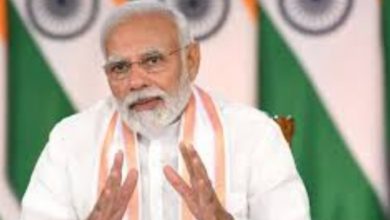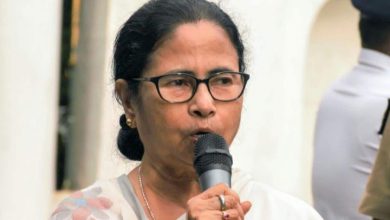After election, cautious optimism that few false narratives took hold

On the morning of Election Day, Charlie Kirk, the conservative talk show host from Arizona, shared a video on Twitter about broken voting machines in Maricopa County, followed a series of posts suggesting that the problems were intentional.
“This is manufactured chaos,” he wrote, calling for those responsible to be arrested.
The video was shared nearly 20,000 times and liked more than 30,000 users, including many prominent accounts with hundreds of thousands of followers. The post and others like it on a dozen online platforms kindled a false narrative of widespread voting shenanigans among those predisposed to believe that the country’s elections are rigged.
And yet as Election Day unfolded, that narrative’s momentum seemed to wane.
Former President Donald Trump made a series of posts on his own platform, Truth Social, about voting issues on Tuesday in Pennsylvania, Arizona and Michigan. Later, though, he shifted his ire to candidates who did poorly, including ones he had endorsed, like Don Bolduc and Joe O’Dea, the Republicans who lost Senate races in New Hampshire and Colorado.
The major social media platforms all struggled to combat misinformation and disinformation online as the results were tabulated, but researchers who study the problem said efforts to stoke doubt about the outcome of the U.S. democratic process had — at least so far — failed to take root.
Some saw it as a hopeful sign of the political system’s resilience, although few declared victory in the fight against misinformation.
In a briefing Wednesday, leaders of Common Cause, the nonpartisan government accountability group, said the election had gone more smoothly than many had feared despite “small adminrative issues” in some polling stations that were being framed online as evidence of conspiracies. The big turnout of voters was evidence that they had rejected “election denialism based on falsehoods,” said Khalif Ali, the director of Common Cause Pennsylvania.
Rep. Adam Kinzinger, R-Ill., who broke with Trump and his party over claims that the 2020 presidential election was stolen, echoed that Tuesday night. “Election deniers are losers tonight,” he wrote on Twitter.
That is not entirely true, however, and that, too, may help explain why more narratives of election fraud have not spread more widely. According to a New York Times analysis, more than half of 370 candidates who in some way had cast doubt on President Joe Biden’s victory had won their races as of midday Wednesday,
They included 170 members of the House, where Republicans appeared to be closing in on reclaiming a majority. Although the party fell short of the “red wave” that many had anticipated, its successes may have tempered some of the conspiracy theories that emerged early Tuesday.
With prominent Republican candidates still on the cusp of winning, calling attention to fraud could undercut those victories, including majority control of the House and Senate. Kirk, who endorsed the Republican nominees for governor and senator in Arizona, predicted that both would prevail when the last votes were counted.
“What happened in this state last night was very special,” he wrote Wednesday.
The legacy platforms — Twitter, Facebook and YouTube — said they had removed thousands of posts that included election misinformation Tuesday, but prominent figures still spread false narratives online.
Twitter, now owned Elon Musk, faced criticism through the day for not taking down misleading posts, although it did tag at least one of Kirk’s as misleading late Tuesday.
“I felt like we’re seeing supply of disinformation stay steady and high — particularly around election denialism rhetoric,” said Nora Benavidez, senior counsel at Free Press, an advocacy group for digital rights and accountability. “But demand seems somehow lower than feared as voters displayed resilience this election cycle to the lies that have tried to sway them in the ballot box.”
TikTok, which has an estimated 1.6 billion monthly active users globally, said it was labeling posts related to the midterms with links that directed users to an Elections Center hub stocked with voting information from authoritative sources. The company blocked politicians and political parties from fundraising on the platform and has said it is trying to educate users about its sponsorship rules, which prohibit creators from being paid to produce political content.
TikTok has struggled to monitor misinformation on its video-focused platform, which is governed a little-understood but powerful recommendation algorithm. A recent experiment misinformation researchers found that TikTok had failed to catch 90% of ads featuring false and misleading messages about elections, while YouTube and Facebook identified and blocked most of them.
YouTube committed $15 million to hire more than 100 content moderators to help with the U.S. midterm and Brazilian elections, on top of more than 10,000 exing moderators. The company also said it had adjusted its recommendation algorithm to not suggest political content from unverified sources to other viewers, and had established a war room to remove videos and livestreams in real time on Election Day.
Media Matters, an advocacy organization, found that YouTube channels continued to peddle claims of voter tabulation irregularities in Spanish in Illinois, Pennsylvania and Arizona. Some of those videos direct viewers to other platforms, where they can share additional commentary or conspiracy theories. While the platform banned conspiracy theories claiming that the 2020 presidential election was stolen, it did not undertake a similar measure this year.
Meta, which announced job cuts the day after the vote, had reduced teams working on the elections in the months leading up to them. The company said it was committed to taking many of the precautions it put in place before the 2020 presidential elections, including temporarily suspending all “political, electoral and social issue” ads from its platforms.
Meta, which owns Instagram and WhatsApp, also removed posts that promoted voter suppression, and rejected ads that discouraged people from voting.
With several races still undecided, false or misleading information continued to appear on major platforms Wednesday, including questions about the pace of tabulating votes in Nevada, where the Senate race could decide which party controls the body.
On alternative platforms, including some associated with political extremism and violence, there was no sign of moderation at all.
“There is a lot of anger and noise on the mainstream platforms like Twitter and Facebook, but the most aggressive statements on the day of the midterms, including calls to violence, are found on the alt platforms including Gab, Parler and Telegram,” said Alex Stamos, the director of the Stanford Internet Observatory, which tracked election disinformation online as part of the Elections Integrity Partnership.
A torrent of content on those sites, all of which cater to conservative users, continued to fume over the outcome. On Gab, Truth Social and his own livestream, Mike Lindell, the CEO of My Pillow and a prominent election denier, railed against the outcome, saying election officials had orchestrated a “Biden bump” in many races.
On other sites, users in some cases called for storming polling stations or using violence, although no significant attacks unfolded on Election Day.
“As Twitter, Facebook, YouTube and others gear up to censor any and all conversations exposing voter fraud, Gab’s election policy is simple: the First Amendment,” Gab’s founder, Andrew Torba, wrote before the vote. “We are not going to police discussions about the election before, during or after the vote. We will not be ‘fact-checking’ content.”





